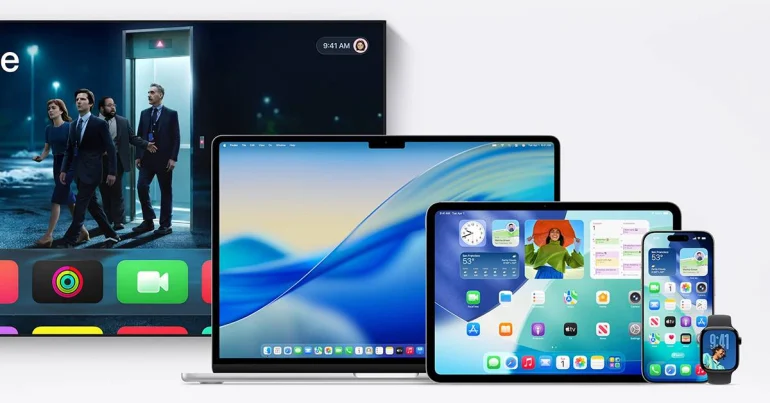Apple unveils Liquid Glass at WWDC 2025 – a groundbreaking design language for iOS 26 that transforms your iPhone experience. Discover the features, benefits, and what it means for users.
Apple has once again redefined the smartphone experience with the introduction of Liquid Glass, a revolutionary design language that promises to transform how we interact with our devices. Announced at WWDC 2025, this isn’t just another visual update – it’s a complete reimagining of Apple’s interface philosophy that bridges the gap between digital and physical reality.
What is Apple’s Liquid Glass Design Language?
Liquid Glass represents Apple’s most ambitious visual overhaul since the transition from skeuomorphic design to flat design in iOS 7. This new interface combines the optical properties of real glass with fluid digital interactions, creating an experience that feels both familiar and futuristic.
The design language draws inspiration from Apple’s Vision Pro headset, unifying the visual experience across all Apple devices. As Alan Dye, Apple’s Vice President of Design, explained during the WWDC presentation, Liquid Glass achieves “optical qualities of glass and a fluidity that only Apple can achieve.”
Key Visual Elements of Liquid Glass
The Liquid Glass interface transforms traditional iOS elements into dynamic, glass-like components that respond to light, movement, and user interaction. App icons appear crafted from multiple layers of liquid glass, while system interfaces like the Lock Screen and Control Center adopt translucent, refractive properties that mirror real-world glass behavior.
Revolutionary Features That Set Liquid Glass Apart
Dynamic Light Interaction
One of the most striking aspects of Liquid Glass is its sophisticated light simulation. Interface elements automatically adjust their appearance based on environmental lighting conditions, creating a more immersive and contextually aware user experience. The design refracts and reflects light just like physical glass, adding depth and realism to every interaction.
Adaptive Typography and Layout
The Lock Screen showcases this innovation beautifully with its glassy San Francisco typeface that dynamically adjusts weight, width, and height based on wallpaper content. This intelligent adaptation ensures optimal readability while maintaining the aesthetic integrity of the glass-like interface.
Spatial Photo Enhancement
iPhone users will benefit from automatic 2D photo conversion to spatial scenes with 3D effects. This feature perfectly complements the glass-like interface, creating a cohesive visual experience that makes photos feel more alive and engaging.
Real-Time Content Response
Liquid Glass interfaces respond instantly to user input and content changes. Alerts emerge from tap locations, context menus expand fluidly when scrolled, and the entire interface adapts its color palette based on displayed content and ambient lighting conditions.
Cross-Platform Integration: More Than Just iPhone
Universal Apple Ecosystem
Liquid Glass extends beyond iOS 26 to encompass iPadOS 26, macOS Tahoe 26, watchOS 26, and tvOS 26. This unified approach ensures a consistent experience whether you’re switching between your iPhone, iPad, Mac, or Apple Watch.
Enhanced Developer Tools
Apple provides developers with comprehensive tools through SwiftUI, UIKit, and AppKit, along with new APIs specifically designed for Liquid Glass implementation. This enables third-party developers to create applications that seamlessly integrate with the new design language.
Technical Innovation Behind the Scenes
Real-World Glass Research
Apple’s commitment to authenticity led their design team to work with industrial design studios, fabricating actual glass samples with varying opacities and lensing properties. This hands-on approach ensured that digital interfaces accurately replicate the visual and optical characteristics of real glass.
Computational Requirements
The sophisticated visual effects of Liquid Glass require significant computational power. Craig Federighi, Apple’s Senior Vice President of Software Engineering, acknowledged the additional processing demands, which may impact battery life and performance on older devices.
User Experience and Practical Benefits
Improved Navigation Clarity
Liquid Glass prioritizes hierarchy between content and controls, making navigation more intuitive. The translucent design elements help users focus on important information while maintaining visual appeal.
Customization Options
The interface offers three distinct modes: light mode, dark mode, and a new clear mode. This flexibility allows users to adapt their device appearance to personal preferences and usage scenarios.
Enhanced Entertainment Features
Apple Music integration showcases Liquid Glass capabilities with artist-provided animations during playback, creating a more engaging music streaming experience that rivals current offerings from competitors like Spotify.
Industry Reception and Critical Analysis
Positive Response
The tech community has largely praised Apple’s technical achievement in recreating realistic glass properties digitally. The attention to detail and sophisticated engineering required for accurate light refraction and reflection has impressed industry experts and users alike.
Areas of Concern
Some users have reported readability issues with overly transparent elements, particularly in high-contrast environments like direct sunlight. Design professionals have also noted that the visual effects might occasionally distract from app content.
Additionally, concerns about planned obsolescence have emerged, as the computational requirements for Liquid Glass may limit compatibility with older Apple devices.
The Future of Apple Design
Design Philosophy Evolution
Liquid Glass marks a significant departure from the flat design principles popularized during Jony Ive’s tenure at Apple. This shift toward more expressive, skeumorphic elements suggests Apple’s willingness to embrace visual complexity when it enhances user experience.
Potential Applications
The glass-like interface hints at Apple’s broader ambitions for spatial computing and augmented reality. This design language could seamlessly extend to future AR glasses or other surfaces, creating a unified experience across all Apple touchpoints.
Conclusion
Apple’s Liquid Glass represents more than a visual refresh—it’s a bold step toward more immersive, intuitive user interfaces that blur the line between digital and physical reality. While the design language faces some challenges regarding readability and computational requirements, its innovative approach to interface design sets a new standard for the industry.
As iOS 26 rolls out across Apple’s ecosystem, users can expect a more engaging, responsive, and visually stunning experience that showcases Apple’s continued commitment to design excellence and technological innovation. Whether you’re a long-time Apple user or considering your first iPhone, Liquid Glass promises to transform how you interact with your devices in meaningful and delightful ways.

